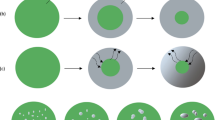Abstract
The chemical potential of O for the coexistence of Ni + NiO and Ni + Cr2O3 + NiCr2O4 equilibria has been measured employing solid-state galvanic cells, (+) Pt, Cu + Cu2O // (Y2O3)ZrO2 // Ni + NiO, Pt (-) and (+) Pt, Ni + NiO // (Y2O3)ZrO2 // Ni + Cr2O3 + NiCr2O4, Pt (-) in the temperature range of 800 to 1300 K and 1100 to 1460 K, respectively. The electromotive force (emf) of both the cells was reversible, reproducible on thermal cycling, and varied linearly with temperature. For the coexistence of the two-phase mixture of Ni + NiO, δΜO 2(Ni + NiO) = −470,768 + 171.77T (±20) J mol−1 (800 ≤T ≤ 1300 K) and for the coexistence of Ni + Cr2O3 + NiCr2O4, δΜO 2(Ni + Cr2O3 + NiCr2O4) = −523,190 + 191.07T (±100) J mol−1 (1100≤ T≤ 1460 K) The “third-law” analysis of the present results for Ni + NiO gives the value of ‡H o298 = -239.8 (±0.05) kJ mol−1, which is independent of temperature, for the formation of one mole of NiO from its elements. This is in excellent agreement with the calorimetric enthalpy of formation of NiO reported in the literature.
Similar content being viewed by others
Reference
J.D. Tretjakow and H. Schmalzried:Ber. Bensenges. Phys. Chem., 1965, vol. 69, pp. 396–402.
H. Davies and W.W. Smeltzer:J. Electrochem. Soc, 1974, vol. 121, pp. 543–49.
W. Kunnmann, D.B. Rogers, and A. Wold:J. Phys. Chem. Solids, 1963, vol. 24, pp. 1535–38.
S.C. Schaefer: Rept. Invest. No. 9043, U.S. Bureau of Mines, Albany, OR, 1986.
S.C. Kung:Metall. Trans. B, 1991, vol. 22B, pp. 673–75.
F. Muller and O.J. Kleppa:J. Inorg. Nucl. Chem., 1973, vol. 35, pp. 2673–78.
R.D. Holmes, H. St. C. O'Neill, and R.J. Arculus:Geochim. Cosmochim. Acta, 1986, vol. 50, pp. 2439–52.
C.B. Alcock and B. Li:J. Am. Ceram. Soc, 1990, vol. 73, pp. 1176–80.
G.M. Kale and D.J. Fray: University of Leeds, Leeds, unpublished research, 1992.
M.W. Chase, Jr., C.A. Davies, J.R. Downey, Jr., D.J. Frurip, R.A. McDonald, and A.N. Syerud:JANAF Thermochemical Tables, 3rd ed., American Chemical Society and American Institute of Physics, National Bureau of Standards, Gaithersburg, MD, 1985.
L.B. Pankratz:Thermodynamic Properties of Elements and Oxides, U.S. Bureau of Mines, Bull. 672, U.S. Government Printing Office, Washington, D.C., 1982.
A.D. Mah, L.B. Pankratz, W.W. Weiler, and E.G. King: Rept. Invest. No. 7026, U.S. Bureau of Mines, Albany, OR, 1967.
B.J. Boyle, E.G. King, and K.C. Conway:J. Am. Chem. Soc, 1954, vol. 76, pp. 3835–37.
K.T. Jacob and C.B. Alcock:Metall. Trans. B, 1975, vol. 6B, pp. 215–21.
J.D. Dunitz and L.E. Orgel:J. Phys. Chem. Solids, 1957, vol. 3, pp. 318–23.
Author information
Authors and Affiliations
Rights and permissions
About this article
Cite this article
Kale, G.M., Fray, D.J. Oxygen potentials in Ni + NiO and Ni + Cr2O3 + NiCr2O4 systems. Metall Mater Trans B 25, 373–378 (1994). https://doi.org/10.1007/BF02663386
Received:
Issue Date:
DOI: https://doi.org/10.1007/BF02663386



